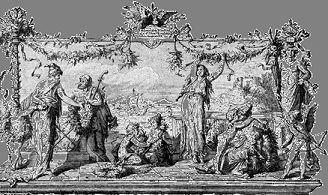Ancient Greek Clothing
Contents |
Ancient Greek Clothing
Ancient Greek clothing was typically homemade and the same piece of homespun fabric that was used as a type of garment, or blanket. From Greek vase paintings and sculptures, we can tell that the fabrics were intensely colored and usually decorated with intricate designs.
Clothing for women and men consisted of two main garments-a tunic (either a peplos or chiton) and a cloak (himation). The peplos was a large rectangle of heavy fabric, usually wool, folded over along the upper edge so that the over fold (apoptygma) would reach to the waist. It was placed around the body and fastened at the shoulders with a pin or brooch. There were armholes were on each side, and the open side of the garment was either left that way, or pinned or sewn to form a seam.
The chiton was made of a much lighter material, normally linen. It was a very long and very wide rectangle of fabric sewn up at the sides, pinned or sewn at the shoulders, and usually girded around the waist. Often the chiton was wide enough to allow for sleeves that were fastened along the upper arms with pins or buttons. Both the peplos and chiton were floor-length garments that were usually long enough to be pulled over the belt, creating a pouch known as a kolpos. Under either garment, a woman might have worn a soft band, known as a strophion, around the mid-section of the body.
Men in ancient Greece customarily wore a chiton similar to the one worn by women, but knee-length or shorter. An exomis (a short chiton fastened on the left shoulder) was worn for exercise, horse riding, or hard labor. The himation (cloak) worn by both women and men was essentially a rectangular piece of heavy fabric, either woolen or linen. It was draped diagonally over one shoulder or symmetrically over both shoulders, like a stole.
Women sometimes wore an epiblema (shawl) over the peplos or chiton. Young men often wore a chlamys (short cloak) for riding. Greek men occasionally wore a broad-brimmed hat (petasos), and on rare occasions, Greek women donned a flat-brimmed one with a high peaked crown. Greek babies wore cloth diapers when it was hot and when it cold they were wrapped up in blankets. Most of the time children wore only cloth (resembling shorts) wrapped around their middles.
Foot Wear
Women and men wore sandals, slippers, soft shoes, or boots, although at home they usually went barefoot.
Materials
Clothes in Greece were made out of three types of materials. The most frequently used material was wool, which was woven from very coarse to very soft. Women and men in Greece wore nearly the same kind of clothes. These clothes were not shaped or fitted to the body, but were instead draped over the body in soft folds. There were basically four types of clothes, which were all rectangles.
Colors
The colors used during this period were bright hued, such as green, indigo, yellow, violet, dark red, dark purple. Colors that were from the Earth were also used. The motifs used ranged from geometric designs like the dentil and arrangement of circles and squares to vegetable forms like the ivy, water leaf and laurel.
Doric Chiton
This was a garment worn to the sixth century and was made up of wool died indigo, madder or saffron and was frequently patterned. The upper edges of this garment was folded over to hang down on the breast, then it was folded round the body and caught together on each shoulder by pins leaving the arms uncovered. Despite the fact that it was open down the right side, it was held in place by the girdle, over which it was bloused. In places like Attica and Corinth, it was sewn together down the side below the waistline. As time passed, this garment grew wider and was known as the Doric chiton. The over-fold also deepened with time so that it was included in the girdling or hung over and concealed the girdle. When it was not girdled, the over-fold could be raised over the head, as a shawl.
Ionic Chiton
This garment was of Phoenician origin and was often seen as a female garment. It was made of thin woolens, probably like crepe and similar to materials that are still woven in Greece. This garment was cut with enough width from two pieces that were sewn together along the top of the extended arm. It was frequently pleated and long and sometimes trailing. This garment was often sewn or caught together all the way down the right side with the left side left open. Men and women wore this garment in many ways. Most of the time the chiton was worn with a short wrap called the chalmydon.
Himation
This is a rectangle piece of wool with weighted corners that is slung over the left shoulder, leaving the right arm free. Married women wore it with the corner of the head like a shawl. Older Dorian women wore it as their only garment. This garment also served as a blanket. This garment was available in natural colors like white, brown, black, crimson, died scarlet and purple. Sometimes it had selvages, woven patterns and embroidery.
Chlamys
This is a term used for a smaller woolen garment that was sometimes bordered and pinned at the right shoulder or the front. Younger, active men mostly wore it with a short chiton or alone.
Peplos
The fabric that was folded over and left hanging down across the top of the Doric chiton was known as the peplos.
References:
